Last Sunday, I ventured into town for the first time since Election Day. The sun came out after five solid days of snow and the roads were sufficiently driveable to melt my excuses for avoiding society. We were badly in need of groceries and I wanted to hit the gym. Still, I was simmering with anger that was hardly dampened by four days of exhausting my mind and body while slogging through the snow.
The streets, stores, and gym were packed with humans and my anger targeted everyone. The election results were a resounding rejection of nearly everything I value, and I wanted to ask them why. To the trail runners who grinned and waved at me as they crossed the crosswalk: Don’t you care about the quality of the air you’re breathing? To the cyclists sprinting up Flagstaff Road: Are you really in favor of deregulation until automakers create trucks so large they could run you over without even feeling a bump? To pedestrians on the sidewalk: Life on the Front Range sure is going to be exciting when climate change creates an endless cycle and fire and flood. To the gym bros: Do you think your muscles are going to save you during the next mismanaged pandemic? To my fellow shoppers at Trader Joes: I hope you’re happy you sold out an entire nation made up of immigrants to rampant xenophobia so that those Gluten Free Pumpkin Spice Streusel Muffins will be six cents cheaper next November, which by the way, they won’t.
Never mind that I never left the Boulder Bubble, in a county that went 76.5% for Harris — although Boulder County went 82% for Biden in 2020, so that annoyed me. And never mind that the Harris campaign presented no great plans for addressing climate change or xenophobia or air quality, but at least they weren’t going to drive the bus at breakneck speeds in the wrong direction. They weren’t quite as likely to hire the absolute worst people to ensure the next pandemic kills us all, and that pandemic is now likely to be polio. So really, fellow denizens of the Boulder Bubble: What now?
That night, I complained to my sister about how the U.S. was likely to go full Handmaid’s Tale before Beat and I can realistically relocate to Switzerland. And even if we could, it’s not like the political dynamic in the rest of the world is all that promising.
“What happened to women like us in the Handmaid’s Tale?” my sister wondered.
“It’s been a while since I read the book, but as I recall the old crones were sent to the work colonies to do hard labor.”
“You’d be good at that,” my sister responded. “Hard labor. Because you love The Slog.” She drew out “The Slog” as though she was the Cryptkeeper introducing a spooky reel. Her enunciation of the phrase brought the first real smile to my face in five days.
She’s right, I thought. I do love The Slog. I might just thrive in a work camp. Oh, you think you can break my spirit? Go ahead and try, because pointless hard work in demoralizing conditions is my favorite thing in the world.
I decided that if rugged individualism is what this world wants, then that’s what I’ll be. I’m going throw my energy into quashing the constant anxiety about the things I can’t change and focus on positive actions that are in my power. If I can succeed in silencing my existential anxieties, I’ll have vast reserves of energy to devote to the wellbeing of myself, my family, friends, and communities. Be the change I want to see in the world. This is honestly the most freeing, empowering realization I’ve had in years. If you’re a passenger on the Titanic, who do you want to be? I want to be the string quartet playing “Nearer my God to Thee” as the ship goes down. Bravely facing the inevitable with an acknowledgement that beauty and love go on.
I decided to spend this week engaging in one positive action every day. It’s not much, but if I can keep it up, these actions have a way of spreading.
On Monday, I finally deactivated my Twitter/X account. I’d been mostly inactive since the Elon takeover, as the place had finally become so toxic that I went cold-turkey on a doomscrolling habit that had gotten out of control during the pandemic. But I was reluctant to deactivate my account since Twitter/X was still such a reliable source of up-to-date info from public agencies on things like wildfires. I also am a huge weather nerd and Twitter/X was a delectable buffet of weather nerdery. But no more. I cut the cord and immediately felt better. So much so that I resolved to also stop actively posting content on Facebook and Instagram. I’m not ready to quit those places, as I maintain so many connections there. But I also feel strongly that I need to do what I can to stop feeding the post-truth machine. Also, it will do my mental health some good to wean myself from the dopaminergic addiction to validation.
On Tuesday, I sent a small donation to the college fund for the kids of my friend who recently lost her 47-year-old husband to a stroke. In the Venmo message, I expressed my gratitude for her guidance in the early days after my father died. I didn’t have the word count to describe how she was the one who first showed me how it was possible to turn one’s grief toward something empowering and meaningful, that grief didn’t have to be the all-encompassing destructive force I still believed it to be. Connie immediately replied via text to tell me she still thought of me often and had been wondering how I’ve been doing with the loss of my dad. She said she was sorry for not contacting me sooner and wanted to send “lots of love.” This broke my heart because Connie just lost her husband and she was still showing so much empathy for a friend she barely sees anymore. We made a plan to meet up for lunch as soon as possible. It probably won’t happen during my next trip to Utah unless I can convince Beat to hang out a few days into December, which I admittedly want to do.
On Wednesday, bolstered by Connie’s love, I finally inquired about something I’ve been talking about wanting to do since my dad died: Donate the funds for a memorial bench to be placed near one of his favorite trails. I’d given it thought and decided that I wanted the location to be the Jacob’s Ladder trail. I reached out to Draper City via e-mail. Within minutes, a city worker replied that while Draper didn’t have jurisdiction over the trail since it was on Forest Service Land, they were working on improvements to nearby trails and could pinpoint a location “Within view of Lone Peak.” An open space manager agreed to meet me on Nov. 27 to check out different locations. I’m so excited about this! I love the idea of supporting Draper City since they’ve done so much to make their open space welcoming and fun for cyclists, hikers, and equestrians alike. Plus, the location will be one that my many relatives in the area could easily visit. My mother, who can’t readily access the places where we spread Dad’s ashes, could visit. The cost is not as high as I’d anticipated. At least it will a lot less than that Moots gravel bike I’ve been eyeing. This will be my Christmas present to myself.
On Thursday, I remembered that Nov. 14 marked one year since my friend Betsy learned she had a brain tumor. I figured it was going to be a tough day for her and reached out first thing in the morning to express my love. She responded that she had a lot of big emotions rising the the surface and she was struggling to contain them all. I responded that she shouldn’t contain these emotions. It’s good to let them out and release the pressure. I told her I hoped she could find places to let in the light and celebrate how much she’d achieved. Indeed, she and her family held a big celebration for her “Alive-iversary.”
In the evening, I got over my trepidation and finally reached out to my friend Wendy. Wendy was my first friend in Boulder, inviting me out for a trail run in a heavy May snowstorm and introducing me to pretty much every famous Boulder trail runner who just happened to also be running Green Mountain that day. But we drifted apart during the pandemic. She responded as though we never missed a beat and we made plans to go snowshoeing in the near future.
On Friday, I wanted to go snowshoeing on trails around Longs Peak, the formidable 14er that I am still too intimidated by exposure, lightning, and summer crowds to summit. On my way out the door, I thought, “I should wear my pussyhat.”
You may remember these cultural remnants from the ancient era of 2017. They were a symbol of women’s solidarity against the misogynistic rhetoric and positions of the incoming president. My Boulder friends Cheryl and Kate planned to attend the Women’s March on Washington, so my Canadian friend Brenda offered to knit hats for them. She sent an extra one for me even though I wasn’t going to the march. I wore my hat around town that January but soon put it in a drawer. The symbolism was always a bit uncomfortable for me — not necessarily its representation of genitalia, but the fact it was pink and cutesy and seemed to trivialize an issue that extended far beyond the privileged white women (ah-hem, raises hand) who marched loud and proud in pink hats while doing little else to leverage our privilege into meaningful change.
Now, it’s eight years later and we have an incoming administration where it’s more of a question of who doesn’t have credible accusations of sexual assault (or animal cruelty) than who does. Project 2025 is horrifying all around and there are no checks and balances left to stop it. I don’t know what to do beyond small, localized acts that I’m determined to continue. The larger issue is truly out of our control. But for this day, I just wanted to remember that moment of hope, to feel that empowering wave of women’s solidarity once again.
The day was gorgeous: Pleasant temperatures, almost windless, bluebird skies, and saturated in the warm November light that I love so much. I was feeling strong — not just “my breathing is better” strong, but “my legs are practically floating over this heavy snow” strong. Not only that, I felt fearless. My confidence and perceived sure-footedness were almost disconcerting because these traits are so unlike middle-aged me. Other hikers were carefully picking their way along steep snowfields while I clomped my own footholds to pass them. Perhaps this pussyhat is infused with superpowers!
I felt so good that after stomping past Chasm Lake that I continued up the Longs Peak route toward the vast Boulderfield. I was fixated on the idea of climbing to the Keyhole and catching its famous view in the gorgeous light of a winter afternoon. But as I climbed, the snow conditions became treacherous. Windblown snow drifts filled the spaces between boulders. Sometimes the snow was a few inches deep, and sometimes it was a few feet deep. It was impossible to know until I took a step and collapsed into the abyss. Even as I took my time and tried to choose wisely, I’d punch hip-deep holes with one foot while the other limb twisted toward the pull of gravity, wrenching my ankles, knees and hips in all sorts of unnerving contortions.
This should have frightened me, but strangely it didn’t. I decided to try hopping from boulder to boulder, which is something I would never try in the summer, because I am not coordinated, and it’s not like jumping was safer now, given the powdery consistency of the snow. After several invigorating but reckless leaps, I missed my target and landed on windblown ground that was thankfully just as solid as the landing I’d anticipated. But I still jarred my knee painfully. Finally the voice of reason screamed out in frustration. “It is 2:45 p.m. Sunset is in two hours. If you sprain or break your knee or ankle, you’re going to have to spend the night up here. No one is going to be able to help you crawl out before morning.”
The sun had long since slipped behind Keyhole Ridge and the wind had picked up with the plummeting temperature. I was nearing 13,000 feet. The siren call of summit fever suddenly dissolved into an eerie recognition of the desolation of this place. A night up here in my emergency bivy sack and puffy coat would be asinine, deeply uncomfortable, and potentially deadly. And yet my heart was pounding with excitement and desire. No. No. I’m too old to be this dumb. I need to shut it down.
I carefully retraced every step I made, drawing thin trenches around the boulders I hopped and struggling through my own hip-deep postholes. It was laborious movement, somehow more exhausting than it had been on the way up. And still, my day of reckless decisions wasn’t done. The full beaver supermoon (heehee, appropriate) rose over the haze-drenched horizon when I was still about three miles from the trailhead. Just as I was taking off my pack to find my headlamp, a group of three college-aged hikers — two men and a woman — jogged past. One of them nearly trampled me and blurted out an apology as he continued running. “We don’t have lights,” he yelled. “And we’re trying to make a dinner reservation.”
Covering three miles before dark when the sun has already set. It can’t be done. Or can it? Without grabbing my light, I hastily threw my backpack on and loped after them. I kept their pace as we descended into the darkening woods. Over the warm day, the snowpacked trail had deteriorated to a morass of slush and glare ice. I was wearing microspikes but they seemed to have no grip on this greasy surface. And still I ran, catching each slide by windmilling my arms and rotating my hips to realign each errant step.
“My coordination is amazing today,” I thought, feeling smug and powerful. Where was anxiety to remind me that a mistake only needs to happen once and then it’s a night in a bivy sack for me? I thought my now-reliable anxiety quashed the last semblance of youthful hubris years ago. This was so strange.
While running, I managed to catch and pass the woman and one of the men. I made it to my car without grabbing my headlamp, although the last quarter mile was especially dicy after I missed seeing a switchback and plunged into knee-deep snow. Still, I was inside my car at 5:12 p.m. when the sun had set at 4:44. I felt like I’d won a race. I removed my hat and gloves and started the ignition. That’s when the gravity of all of the risks I’d taken set in. I glanced at the hat with unsettling suspicion.
On Saturday, I decided I needed a large serving of humble pie, so I visited Niwot Ridge. The weather forecast was markedly worse, with temperatures as much as 25 degrees colder and strong winds carried in on a cold front. Niwot Ridge sits beneath the Continental Divide with the unique geology necessary to create a veritable wind tunnel, sucking chilled air like a straw toward the balmy Plains. Hurricane-force winds are not unlikely. If the wind is blowing at 30 mph in nearby Ward, it could be 70 mph up here at 12,000 feet. Those familiar with “blowholes” in Alaska will be pleased to hear we have our very own version here in Colorado.
I consider Niwot Ridge to be my home “soul mountain” and approach it like it’s an old friend. I have so much love for this place. It’s so different from the majestic spires of the nearby Indian Peaks. It’s a squat little ridge with no discernible summit, littered with battered and rusted research gear. It’s a mountain where pretty much no one goes ever, from the most popular weeks of summer to the most brutal weeks of winter. The weather here is nearly always terrible, but when it’s not, Niwot loses some of its magic. So I was giddy to see the mountains draped in an opaque wall of white as I drove west beneath otherwise clear skies.
Why do I love Niwot Ridge so? For its solitude. For its stark desolation. For its fearsome weather that makes me feel like a small bit of flesh braced against the vacuum of the all-encompassing void. Niwot reminds me that my human problems are laughably small and my human existence is unequivocally fragile. Life is such a gift. I come here to struggle along the edge of what’s survivable and remember that.
On Sunday, I donated to a person who requested help for mental health care in a local group that I follow on Facebook, then I finished cleaning up my Facebook account. At the beginning of the week, when I resolved to stop posting “look at me” content on the platform, I realized that I had 3,952 friends. Back when I was promoting my books on social media, I’d accept friend requests from all. It’s been a while since I felt that was necessary, but this bloated list was full of strangers and people with whom I have few connections. So I decided to slim down my list to people I currently know in real life or people I want to continue following for other reasons. It took five days do the unfriending because Facebook kept locking my profile for “not meeting community standards.” I now have 646 Facebook friends — still more than I expected, but it seems more manageable. Unsurprisingly, my Facebook feed is still 85% junk content from sources I don’t even follow, as most of my IRL friends are as inactive as I wish to be. But it’s a start. I still don’t intend to quit Facebook, as the groups I intentionally follow still provide a lot of valuable information. And it’s a good forum to find people who need help and don’t know where else to turn.
My activities throughout the week had done a number on my old crone body parts — especially my hips which did not like the Boulderfield postholing — but I didn’t want to skip leg day. My gym sessions have been going well, and I credit these strengthening exercises with helping me miraculously avoid injury this week.
Plus, I intend to be strong when the work camp wardens come for me. They’re not going to break my spirit.

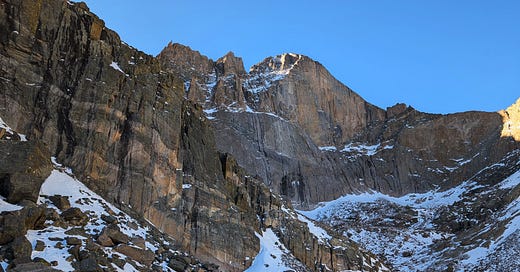



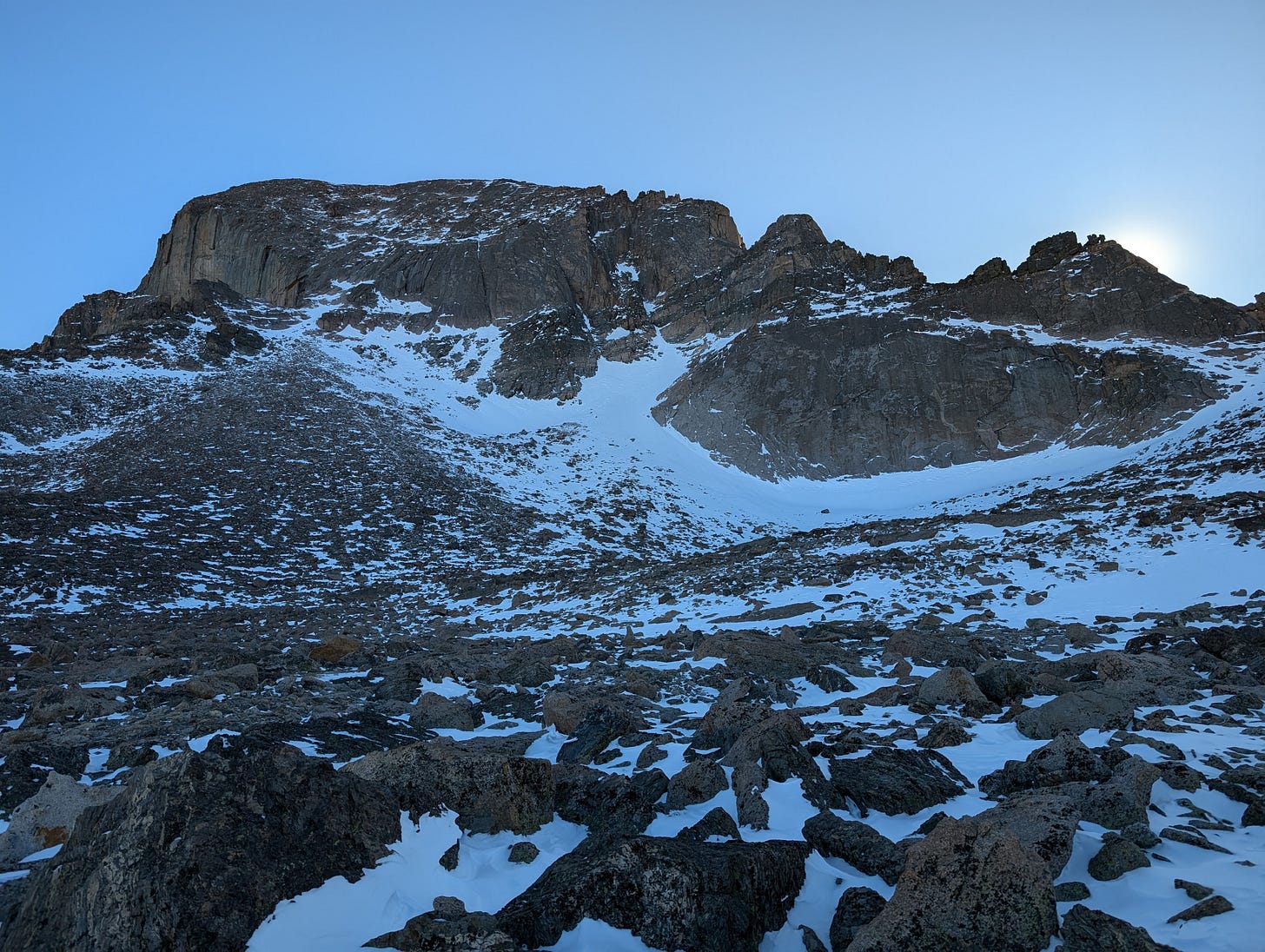

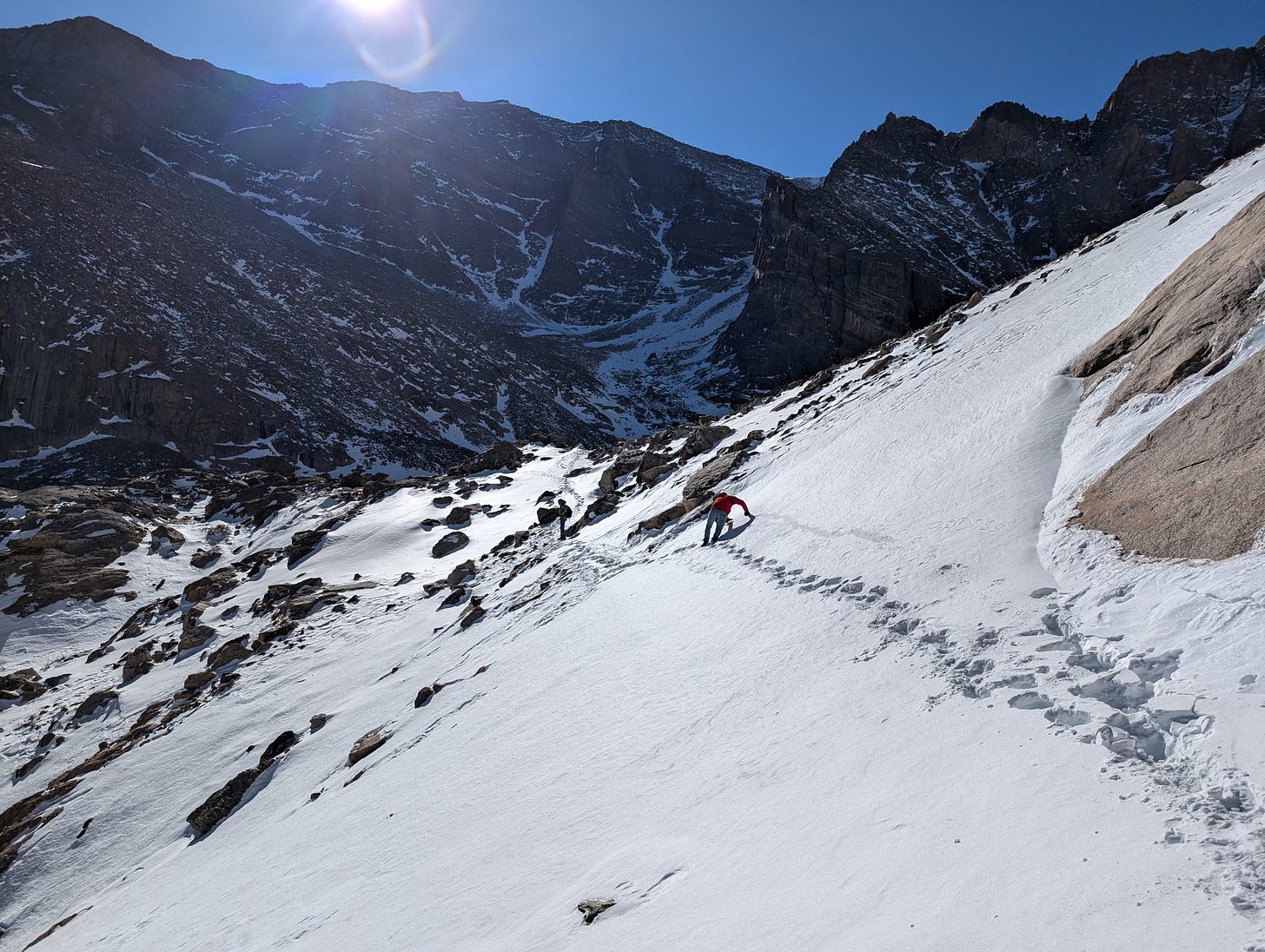
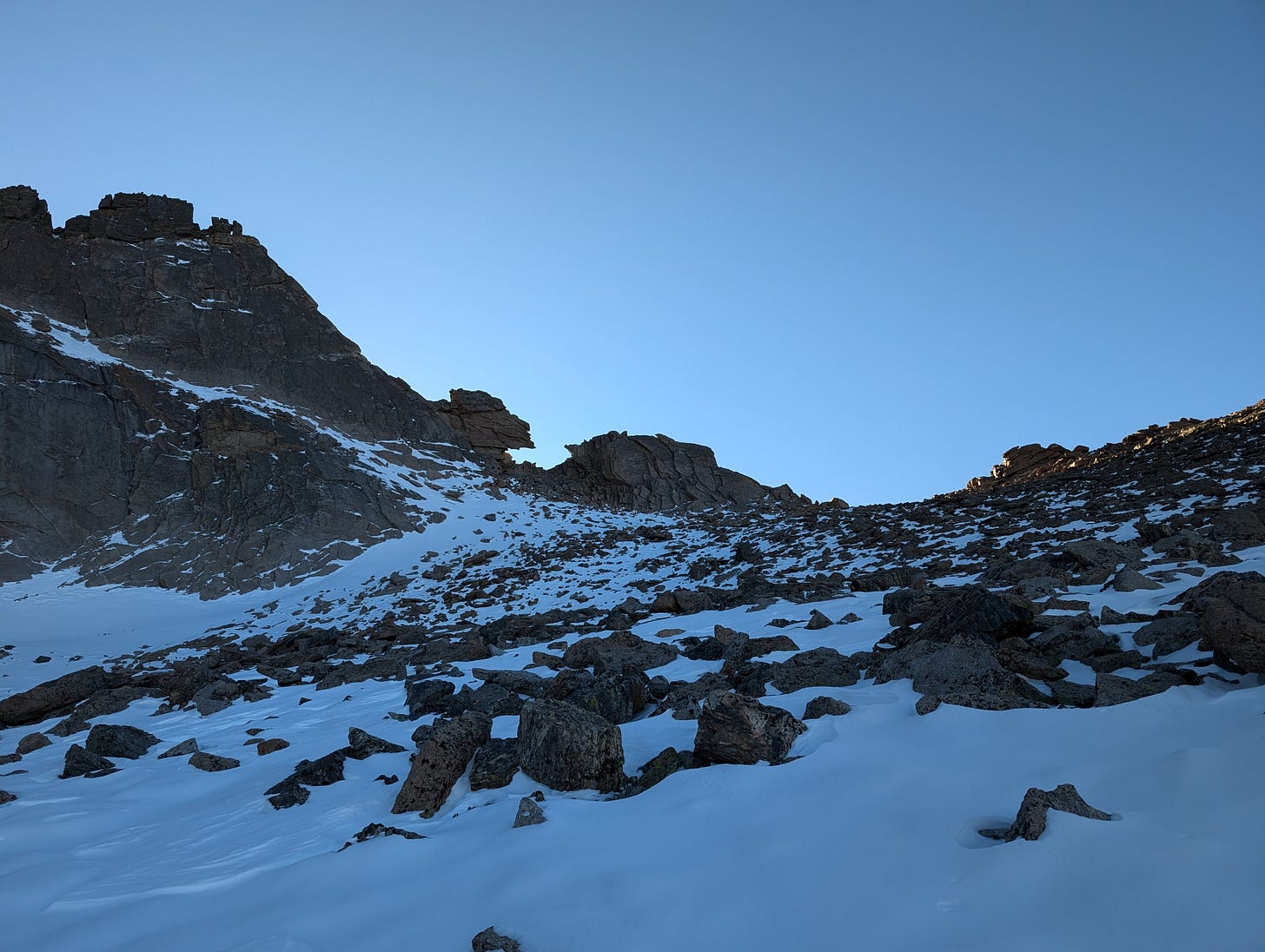
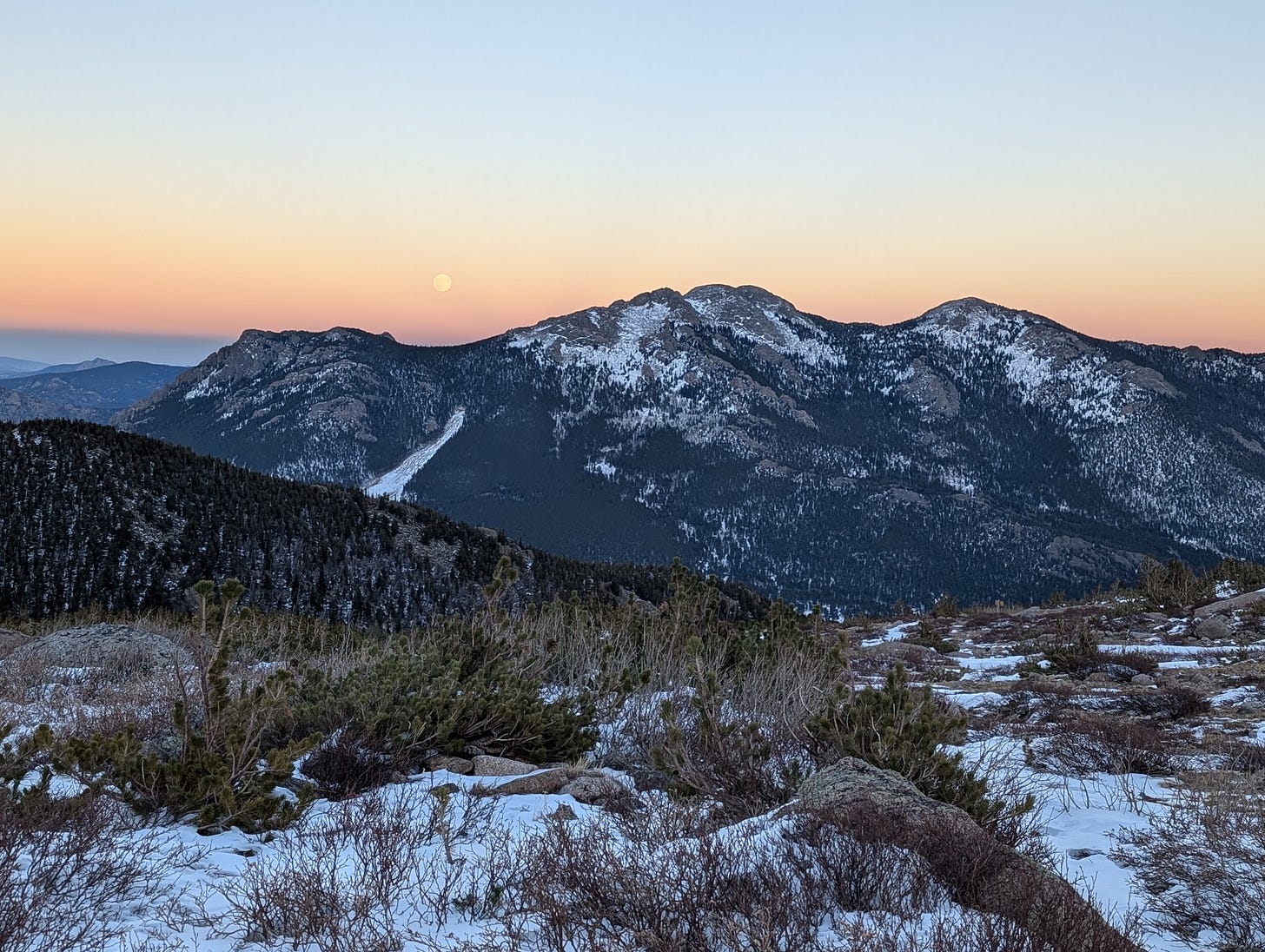
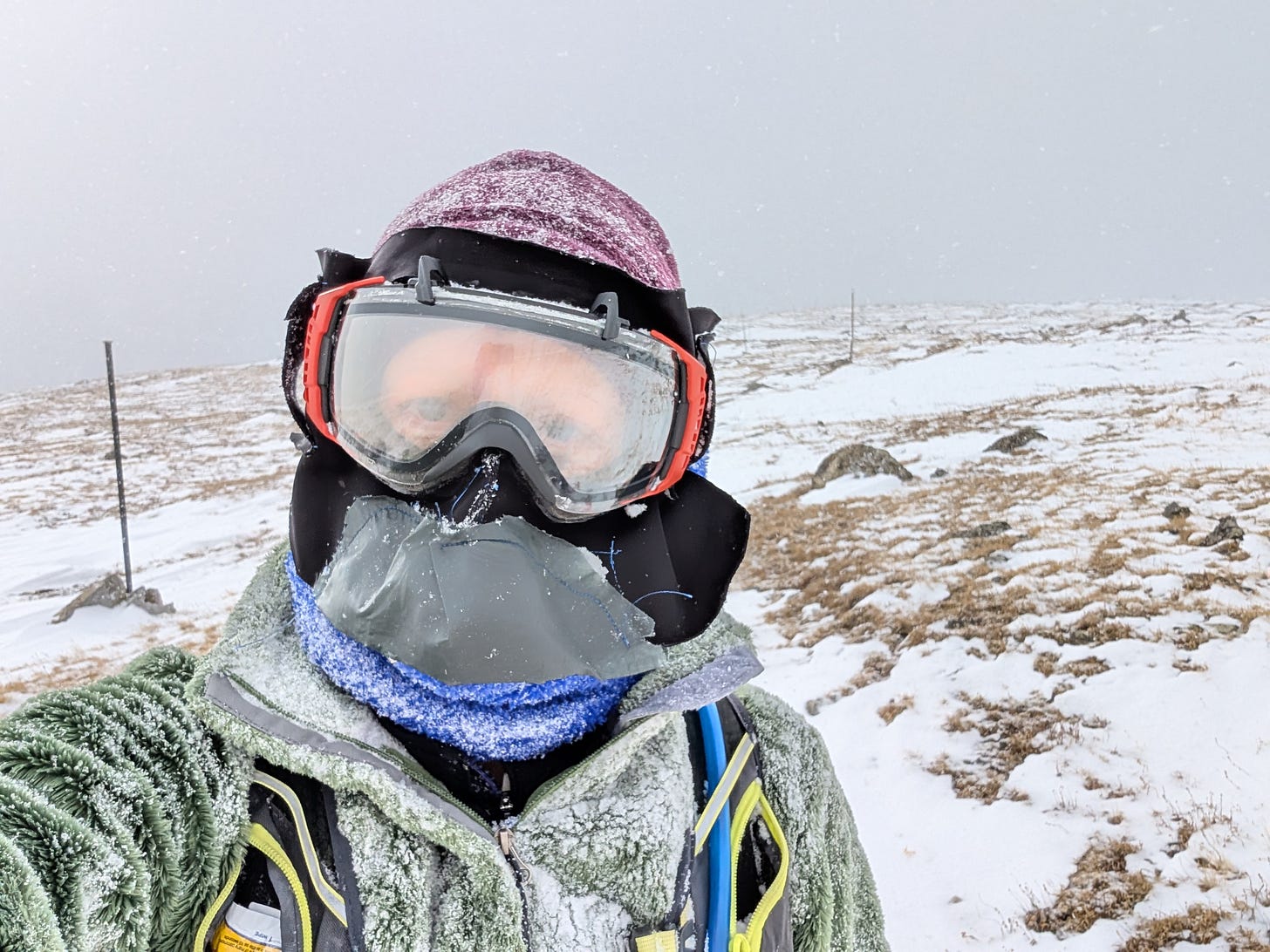


Yay, I'm still in the Facebook friend bubble. I went in and got rid of the people who excessively gloated over the election results. I had been keeping them because I've known them for decades but I don't believe I can just "agree to disagree" anymore. But like you I've decided to tone down some of my social media posting.
. . . and I made the friend bubble as well! For several months now I have been slow to read your writings because I have been in a very weird headspace. Someday I will write an email to explain. I’m so glad you’ve been able to tackle the world this last week. Your Jill Homer!!! You can tackle anything’